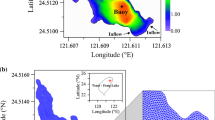Abstract
This article presents the modeling of hydrothermal characteristics and suspended solids in a long and large-volume reservoir with a highly fluctuating water level. A laterally averaged two-dimensional hydrothermal and water quality model was configured for the Shihmen Reservoir in northern Taiwan. The model was validated with measured data of water surface elevation, water temperature, and concentration of suspended solids in 2006. The results show that the numerical model was able to reproduce the measured data. The validated model was then used to investigate the effects of water withdrawal schemes at different depths and to estimate the residence time in the reservoir. When water is withdrawn from a great depth, the relatively warm water from the upper layers can replace that in the deep layers, thereby facilitating heat transfer from the surface to the deeper layer. Bottom-water withdrawal results in a lower concentration of suspended solids compared with withdrawal from depths of 20 and 40 m. The simulated results show that the residence time is approximately 154 days in the Shihmen Reservoir.







Similar content being viewed by others
References
Afshar A, Saadatpour M (2009) Reservoir eutrophication modeling, sensitivity analysis, and assessment: application to Karkheh Reservoir, Iran. Environ Eng Sci 26(7):1227–1238
Ambrosetti W, Barbanti L, Sala N (2003) Residence time and physical processes in lakes. J Limnol 62(1):1–15
Bartholow J, Hanna RB, Saito L, Lieberman D, Horn M (2001) Simulated limnological effects of the Shasta Lake temperature control device. Environ Manage 27(4):609–626
Chung SW, Gu RR (2009) Prediction of the fate and transport processes of Atrazine in a reservoir. Environ Manage 44(1):46–61
Cole TM, Buchak E (1995) CE-QUAL-W2: a two-dimensional laterally averaged, hydrodynamics and water quality model, version 2.0. US Army Engineers Waterway Experiment Station, Tec. Report EL-95-May 1995, Vicksburg, MS
Cole TM, Wells SA (2000) Hydrodynamic modeling with application to CE-QUAL-W2. Workshop Notes, Portland State University, Portland, OR
De Cesare G, Schleiss A, Hermann F (2001) Impact of turbidity currents on reservoir sedimentation. J Hydraul Eng ASCE 127(1):6–16
Etemad-Shahidi A, Afshar A, Alikia H, Moshfeghi H (2009) Total dissolved solid modeling; Karkheh Reservoir case example. Int J Environ Res 3(4):671–680
Ford DE (1990) Reservoir transport processes. In: Thorton KW, Kimmel BL, Payne FE (eds) Reservoir limnology, ecological perspective. Wiley, New York, pp 15–41
Gelda RK, Effler SW (2007) Modeling turbidity in a water supply reservoir: advancements and issues. J Environ Eng ASCE 133(2):139–148
Kim Y, Kim B (2006) Application of a 2-dimensional water quality model (CE-QUAL-W2) to the turbidity interflow in a deep reservoir (Lake Soyang, Korea). Lake Res Manage 22(3):213–222
Kirk KL (1991) Inorganic particles alter competition in grazing plankton: the role of selective feeding. Ecology 72(3):915–923
Kuo JT, Liu WC, Lin RT, Lung WS, Yang MD, Yang CP, Chu SC (2003) Water quality modeling for the Feitsui Reservoir in northern Taiwan. J Am Water Resour Assoc 39(3):671–687
Rueda F, Moreno-Ostos E, Armengol J (2006) The residence time of river water in reservoirs. Ecol Model 191(2):260–274
Soeken-Gittinger LA, Stoeckel JA, Havel JE (2009) Differing effects of suspended sediments on the performance of native and exotic Daphnia. Freshw Biol 54(3):495–504
Sullivan AB, Jager HI, Mayers R (2003) Modeling white sturgeon movement in a reservoir: the effect of water quality and sturgeon density. Ecol Model 167(1–2):97–114
Thornton KW, Kimmel BL, Payne FE (1990) Reservoir limnology: ecological perspectives. Wiley-Interscience, New York
Wetzel RG (2001) Limnology-lake and river ecosystems, 3rd edn. Academic Press, London
Zhang H, Culver DA, Boegman L (2008) A two-dimensional ecological model of Lake Erie: application to estimate dreissenid impacts on large lake plankton populations. Ecol Model 214(2–4):219–241
Acknowledgments
The research was conducted as part of a grant supported by the National Science Council, Taiwan, Grant No. 96-2628-E-239-012-MY3. This financial support is greatly appreciated. The authors would like to thank the Northern Region Water Resources Bureau for providing the measured data used in the model validation.
Author information
Authors and Affiliations
Corresponding author
Rights and permissions
About this article
Cite this article
Liu, W.C., Chen, W.B. Modeling hydrothermal, suspended solids transport and residence time in a deep reservoir. Int. J. Environ. Sci. Technol. 10, 251–260 (2013). https://doi.org/10.1007/s13762-012-0147-2
Received:
Revised:
Accepted:
Published:
Issue Date:
DOI: https://doi.org/10.1007/s13762-012-0147-2




